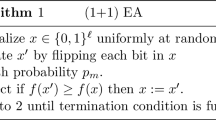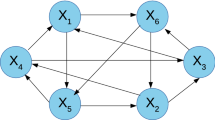Abstract
Evolutionary algorithms (EAs) are randomized optimization search techniques, and the theoretical study of the first hitting time is very important in the practical applications of EA. We investigate the first hitting time of Leading Ones (LO) problem theoretically on Random Local Search (RLS) algorithm and (1 + 1)EA by absorbing Markov chain. This paper reports the calculation method of the first hitting time on LO problem with (1 + 1)EA and RLS. We found that the results only depend on the length of string, and the hitting times can be given approximately by the quadratic function. In the numerical experiments, we showed the agreement between the results of the practical calculation and the theoretical results. Our results give the good example to predict the running time of the practical EA calculations by Markov chain method.


Similar content being viewed by others
References
Auger A, Doerr B (2011) Theory of randomized search heuristics. World Scientific, Singapore
Wegener I (2001) Methods for the analysis of evolutionary algorithms on pseudo-Boolean functions. In: Sarker R, Mohammadian M, Yao X (eds) Evolutionary optimization. Kluwer Academic Pubishers, Dordrecht, pp 349–369
Iosifescu M (1980) Finite Markov chain processes and their applications. Wiley, New York
Levin DA, Peres Y, Wilmer EL (2008) Markov chains and mixing times. American Mathematical Society, Providence
Furutani H, Tagami H, Sakamoto M, Du Y (2014) Markov chain analyses of random local search and evolutionary algorithm. J Robot Netw Artif Life 1(3):220–224
Furutani H, Sakamoto M, Du Y, Aoki K (2015) Analysis of asymmetric mutation model in random local search. J Robot Netw Artif Life 2(1):1–4
Du Y, Aoki K, Sakamoto M, Yamamori K, Furutani H (2016) Asymmetric mutation model in genetic algorithm. Artif Life Robot 22:17–23
Jansen T, Sudholt D (2010) Analysis of an asymmetric mutation operator. Evolut Comput 18(1):1–26
Doerr B, Hebbinghaus N, Neumann F (2007) Speeding up evolutionary algorithms through asymmetric mutation operators. Evolut Comput 15(4):401–410
Droste S, Jansen T, Wegener I (2002) On the analysis of the (1 + 1) evolutionary algorithm. Theor Comput Sci 276:51–81
Du Y, Ma Q, Zhang Y, Sakamoto M, Furutani H (2014) Runtime analysis of OneMax problem in genetic algorithm. J Robot Netw Artif Life 1(3):225–230
Du Y, Ma Q, Zhang Y, Aoki K, Sakamoto M, Furutani H (2015) Hitting time analysis of OneMax problem in genetic algorithm. J Robot Netw Artif Life 2(2):131–134
Author information
Authors and Affiliations
Corresponding author
About this article
Cite this article
Du, Y., Aoki, K., Sakamoto, M. et al. Markov chain analysis of Leading Ones problem. Artif Life Robotics 22, 443–448 (2017). https://doi.org/10.1007/s10015-017-0381-2
Received:
Accepted:
Published:
Issue Date:
DOI: https://doi.org/10.1007/s10015-017-0381-2




